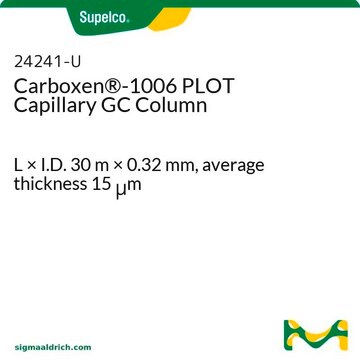Products may be shipped at a different temperature than the recommended long-term storage temperature. If the product quality is sensitive to short-term exposure to conditions other than the recommended long-term storage, it will be shipped on wet or dry-ice. If the product quality is NOT affected by short-term exposure to conditions other than the recommended long-term storage, it will be shipped at ambient temperature. As shipping routes are configured for minimum transit times, shipping at ambient temperature helps control shipping costs for our customers. For more information, please refer to the Storage and Transport Conditions document: https://www.sigmaaldrich.com/deepweb/assets/sigmaaldrich/marketing/global/documents/316/622/storage-transport-conditions-mk.pdf
Kluczowe dokumenty
32221-M
Ethyl alcohol, pure
≥99.8% (GC), absolute, puriss. p.a.
Synonim(y):
Ethyl alcohol
About This Item
Polecane produkty
Nazwa produktu
Ethanol, puriss. p.a., absolute, ≥99.8% (GC)
gęstość pary
1.59 (vs air)
ciśnienie pary
44.6 mmHg ( 20 °C)
klasa czystości
absolute
puriss. p.a.
Próba
≥99.8% (GC)
Formularz
liquid
temp. samozapłonu
683 °F
granice wybuchowości
19 %, 60 °F
metody
GC/GC: suitable
zanieczyszczenia
furfural, in accordance
≤0.0001% free alkali (as NH3)
≤0.0001% heavy metals (as Pb)
≤0.0003% KMnO4 red. matter (as O)
≤0.0005% free acid (as CH3COOH)
≤0.001% acetone (GC)
≤0.001% aldehydes (as CH3CHO)
≤0.001% non-volatile matter
≤0.003% 2-propanol
≤0.003% carbonyl compounds (as CO)
≤0.02% methanol (GC)
≤0.05% iso-amyl alcohol
≤0.2% water (Karl Fischer)
współczynnik refrakcji
n20/D 1.3600 (lit.)
n20/D 1.3614-1.3618
pH
7 (20 °C, 10 g/L)
bp
78 °C (lit.)
mp
−114 °C (lit.)
ślady kationów
Al: ≤0.5 ppm
B: ≤0.02 ppm
Ba: ≤0.1 ppm
Ca: ≤0.5 ppm
Cd: ≤0.05 ppm
Co: ≤0.02 ppm
Cr: ≤0.02 ppm
Cu: ≤0.02 ppm
Fe: ≤0.1 ppm
Mg: ≤0.1 ppm
Mn: ≤0.02 ppm
Ni: ≤0.02 ppm
Pb: ≤0.1 ppm
Sn: ≤0.1 ppm
Zn: ≤0.1 ppm
ciąg SMILES
CCO
przydatność
complies for UV absorption
complies for appearance
complies for identity A
complies for identity B
passes test for reaction against H2SO4
Format
neat
InChI
1S/C2H6O/c1-2-3/h3H,2H2,1H3
Klucz InChI
LFQSCWFLJHTTHZ-UHFFFAOYSA-N
Szukasz podobnych produktów? Odwiedź Przewodnik dotyczący porównywania produktów
Zastosowanie
It may be used in the following studies:
Przypis
Hasło ostrzegawcze
Danger
Zwroty wskazujące rodzaj zagrożenia
Zwroty wskazujące środki ostrożności
Klasyfikacja zagrożeń
Eye Irrit. 2 - Flam. Liq. 2
Kod klasy składowania
3 - Flammable liquids
Klasa zagrożenia wodnego (WGK)
WGK 1
Temperatura zapłonu (°F)
55.4 °F - closed cup
Temperatura zapłonu (°C)
13 °C - closed cup
Wykazy regulacyjne
Wykazy regulacyjne dotyczą głównie produktów chemicznych. Można w nich podawać ograniczoną liczbę informacji na temat produktów niechemicznych. Brak wpisu oznacza, że żaden ze składników nie znajduje się w wykazie. Użytkownik odpowiada za zagwarantowanie bezpiecznego i zgodnego z prawem stosowania produktu.
EU REACH Annex XVII (Restriction List)
Wybierz jedną z najnowszych wersji:
Masz już ten produkt?
Dokumenty związane z niedawno zakupionymi produktami zostały zamieszczone w Bibliotece dokumentów.
-
How is shipping temperature determined? And how is it related to the product storage temperature?
1 answer-
Helpful?
-
-
How can I determine the shelf life / expiration / retest date of this product?
1 answer-
If this product has an expiration or retest date, it will be shown on the Certificate of Analysis (COA, CofA). If there is no retest or expiration date listed on the product's COA, we do not have suitable stability data to determine a shelf life. For these products, the only date on the COA will be the release date; a retest, expiration, or use-by-date will not be displayed.
For all products, we recommend handling per defined conditions as printed in our product literature and website product descriptions. We recommend that products should be routinely inspected by customers to ensure they perform as expected.
For products without retest or expiration dates, our standard warranty of 1 year from the date of shipment is applicable.
For more information, please refer to the Product Dating Information document: https://www.sigmaaldrich.com/deepweb/assets/sigmaaldrich/marketing/global/documents/449/386/product-dating-information-mk.pdfHelpful?
-
-
As this product is not denatured. Can we make it denatured by adding 1% Methanol in it. Request advice.
1 answer-
It is possible to denature Ethanol via the addition of Methanol. The final Methanol concentration is generally above 1%, frequently in the range of 5 to 10%.
Helpful?
-
-
Sehr geehrte Damen und Herren, ist der Ethanol 32221-M (puriss. p.a., absolute, ≥99.8% (GC)) vergällt / denaturiert oder unvergällt / nicht-denaturiert? Leider ist mir das weder von der Homepage noch vom SDB endgültig ersichtlich. Beste Grüße!
1 answer-
This product is not denatured.
Helpful?
-
-
Bonjour, Quelle est la différence entre la référence 32205-1L-M et la référence 32221-1L-M? Merci
1 answer-
These products are physically identical with the same minimum purity specification. Product 32205-M is reagent grade which is suitable for general lab applications. It meets some of the analytical specifications of European Pharmacopoeia and testing includes trace analysis. Product 32221-1L-M is Puriss p.a. grade meaning the testing is also extensive and includes trace analysis. The quality of these products is comparable.
Please see the links below to review the tests and specifications for each item.
33205 Specifications
https://www.sigmaaldrich.com/specification-sheet/SIGALD/3220532221 Specifications
https://www.sigmaaldrich.com/specification-sheet/SIGALD/32221Helpful?
-
Active Filters
Nasz zespół naukowców ma doświadczenie we wszystkich obszarach badań, w tym w naukach przyrodniczych, materiałoznawstwie, syntezie chemicznej, chromatografii, analityce i wielu innych dziedzinach.
Skontaktuj się z zespołem ds. pomocy technicznej





